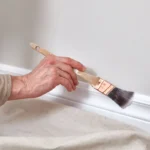Painting a house is a great way to give it a fresh look and increase its value. But before you start, you need to know the correct sequence of painting a house to avoid mistakes and achieve a professional result. In this article, we will explain the steps involved in painting a house, from preparation to finishing touches.
The Correct Sequence of Painting a House
The correct sequence of painting a house is as follows:
- Prepare the surface
- Prime the surface
- Paint the ceiling
- Paint the walls
- Paint the trim, doors, and windows
This sequence ensures that you cover the entire surface evenly and avoid drips, splatters, and overlaps. Let’s look at each step in more detail.
Prepare the Surface
The first step in painting a house is to prepare the surface. This involves cleaning, repairing, and protecting the surface before applying any paint. Here are some tips for preparing the surface:
- Remove any furniture, curtains, rugs, and other items from the room. Cover the floor with drop cloths or plastic sheets to protect it from paint spills.
- Clean the surface with a damp cloth or sponge to remove any dust, dirt, grease, or stains. Use a mild detergent or a specialized cleaner for stubborn stains. Let the surface dry completely before painting.
- Repair any cracks, holes, or damages on the surface with spackle, caulk, or filler. Sand the repaired areas smooth and wipe off any excess dust.
- Protect any areas that you don’t want to paint, such as electrical outlets, switches, baseboards, moldings, or hardware, with painter’s tape or masking tape. Press the tape firmly to prevent paint from seeping under it.
Prime the Surface
The next step in painting a house is to prime the surface. Priming is applying a coat of primer, which is a special type of paint that prepares the surface for the final paint. Priming has several benefits, such as:
- It seals the surface and prevents stains, moisture, or odors from bleeding through the paint.
- It improves the adhesion and durability of the paint and prevents peeling, cracking, or chipping.
- It evens out the surface and covers any imperfections, such as patches, repairs, or color variations.
- It enhances the color and finish of the paint and reduces the number of coats needed.
To prime the surface, use a roller, a brush, or a sprayer, depending on the size and shape of the surface. Apply the primer in a thin and even layer, following the manufacturer’s instructions. Let the primer dry completely before painting, usually for a few hours or overnight.
Paint the Ceiling
The third step in painting a house is to paint the ceiling. Painting the ceiling first prevents any drips or splatters from ruining the walls or the trim. Here are some tips for painting the ceiling:
- Use a paint that is specially formulated for ceilings, such as a flat or a matte paint. These paints have less gloss and reflect less light, which makes the ceiling look smoother and higher.
- Use a roller with an extension pole to reach the ceiling easily and evenly. Start from one corner of the room and work your way across the ceiling in sections. Overlap each section slightly to avoid gaps or lines.
- Use a brush or a small roller to paint the edges of the ceiling where it meets the walls. Be careful not to touch the walls with the paint, or use painter’s tape to protect them.
Paint the Walls
The fourth step in painting a house is to paint the walls. Painting the walls after the ceiling allows you to cover any mistakes or overlaps that may have occurred. Here are some tips for painting the walls:
- Use a paint that suits the style and function of the room, such as a satin, a semi-gloss, or a gloss paint. These paints have more gloss and reflect more light, which makes the walls look brighter and more spacious.
- Use a roller to paint the large and flat areas of the walls. Start from the top of the wall and work your way down in sections. Overlap each section slightly to avoid gaps or lines.
- Use a brush or a small roller to paint the corners, edges, and details of the walls, such as around windows, doors, or fixtures. Be careful not to touch the ceiling or the trim with the paint, or use painter’s tape to protect them.
Paint the Trim, Doors, and Windows
The fifth and final step in painting a house is to paint the trim, doors, and windows. Painting these elements last allows you to create a clean and crisp contrast with the walls and the ceiling. Here are some tips for painting the trim, doors, and windows:
- Use a paint that is durable and resistant to scratches, such as a semi-gloss or a gloss paint. These paints have the most gloss and reflect the most light, which makes the trim, doors, and windows stand out and look elegant.
- Use a brush to paint the trim, doors, and windows. Start from the top and work your way down, following the direction of the wood grain. Use long and smooth strokes to avoid brush marks or drips.
- Remove any painter’s tape or masking tape carefully after the paint is dry. Use a razor blade or a utility knife to cut along the edge of the tape if it is stuck to the paint.
Conclusion
Painting a house is a rewarding and cost-effective way to improve its appearance and value. By following the correct sequence of painting a house, you can achieve a professional and flawless result. Remember to prepare, prime, paint the ceiling, paint the walls, and paint the trim, doors, and windows, in that order. Happy painting!




